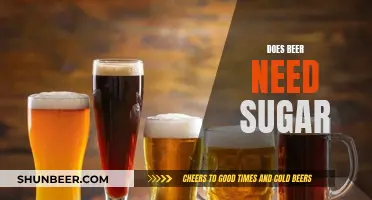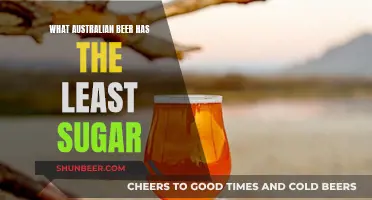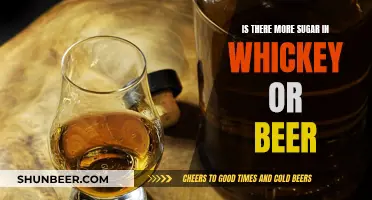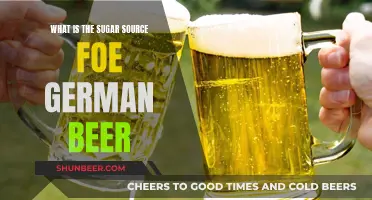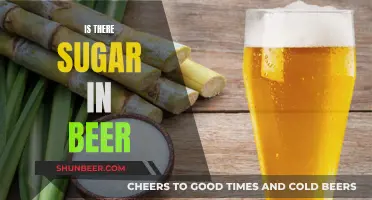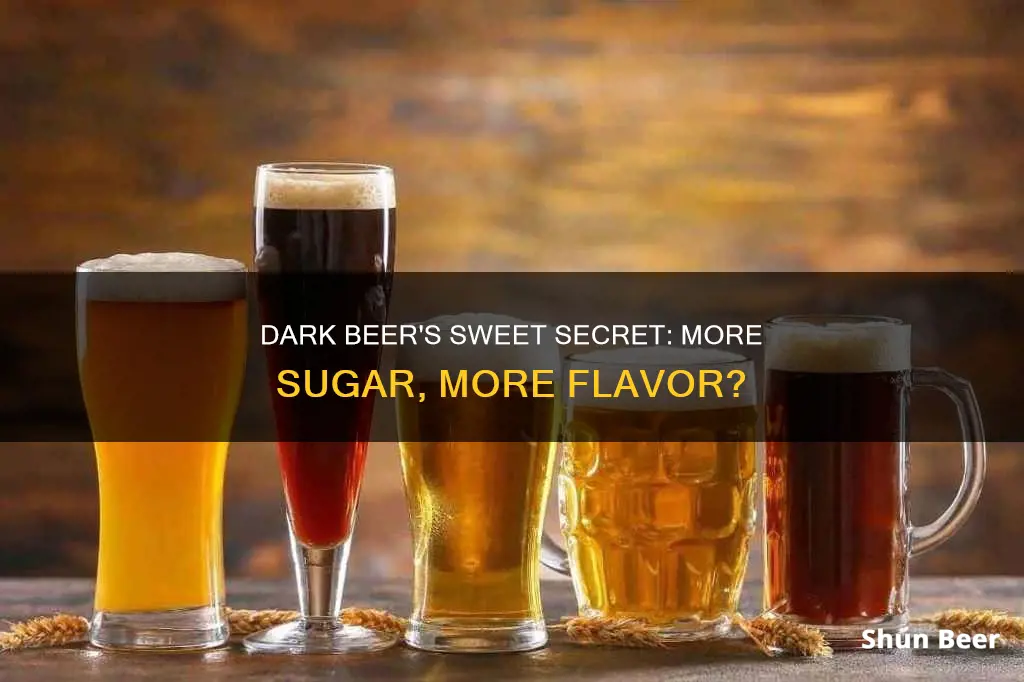
It is a common misconception that darker beers contain more sugar than lighter beers. While it is sometimes true that darker beers contain more sugar, it is not always the case. The colour of a beer is directly related to its malt content, and less malt is needed for dark beers than light-coloured beers. This means that dark beers can use less grain than lighter beers, and therefore less sugar. The sugar content of a beer is indicated by its ABV – the higher the ABV, the more maltose is used, and the more calories in the beer.
What You'll Learn

Dark beers are made with roasted malt
It is a common misconception that darker beers contain more sugar than lighter beers. While this is sometimes true, it is not always the case.
However, less malt is needed for dark beers than for light-coloured beers. This is because a small amount of dark malt goes a long way in creating a darker-coloured beer. Think of it in terms of food colouring: you only need a few drops of dark food colouring to achieve a dark colour, whereas a lighter colour may require several more drops. This means that dark beers can use less grain than lighter beers, and therefore less sugar.
The colour of a beer is directly related to its malt content. The fermentable sugar in most craft beers comes from malted barley that has been germinated and kilned. Additional colour and malt flavour come from the roasting process.
The malt spectrum of colours and flavours can be broken down as follows:
- Light roasted malts yield straw and golden colours and biscuit flavours.
- Medium roasts yield amber and copper colours and caramel and nut flavours.
- Darker roasts yield brown and light black colours and chocolate and coffee flavours.
- The heaviest roasts yield black colours and burnt flavours.
Most craft beers are made up of 75-100% base malts, the palest malts on the spectrum. Dark malts, by comparison, typically only make up 1-5% of the overall recipe.
Coke vs Beer: Which Drink Contains More Sugar?
You may want to see also

Dark beers can have lower sugar content than lighter beers
It is a common misconception that darker beers contain more sugar than lighter beers. While this is sometimes true, it is not always the case. The colour of a beer does not determine its sugar content.
The sugar content of a beer depends on the amount of sugar fermented by the yeast. The yeast consumes the sugar in the wort (the early stage of beer) and excretes alcohol, so the more sugar that is fermented, the higher the alcohol content and the lower the sugar content.
The colour of a beer is directly related to its malt content. Darker beers are made with roasted malt, which is a type of grain that has been roasted until it achieves a darker colour. However, less malt is needed for dark beers than light-coloured beers. This means that dark beers can use less grain than lighter beers, and therefore less sugar.
The "lightest of the darkest" styles of beer include black lagers (or schwarzbiers), porters, and dry stouts. These beers are light-bodied and have a low alcohol content, ranging from 4.2% to 6% ABV. They are smooth, moderately crisp, and highly carbonated, with little to no malt or roasted flavour.
In summary, while it is true that some darker beers contain high levels of sugar, this is not always the case. Dark beers can have lower sugar content than lighter beers due to the smaller amount of malt required in the brewing process.
Sugar Secrets: Priming Beer with Precise Sugar Grams
You may want to see also

The colour of a beer is not related to its alcohol content
It is a common misconception that darker beers contain more sugar than lighter beers. While darker beers are made with roasted malt, which is a type of grain that has been roasted to achieve a darker colour, less malt is needed for dark beers than for light-coloured beers. This means that dark beers can use less grain and, therefore, less sugar than their lighter counterparts.
The alcohol content of beer is determined by the amount of sugar that has been fermented by the yeast. The higher the alcohol content, the more sugar was used in the fermentation process. Therefore, the alcohol content of beer is related to the sugar content, but the colour of the beer is not an indicator of its sugar content.
The colour of a beer is directly related to its malt content. The majority of craft beers are made up of 75-100% base malts, the palest malts on the spectrum. Dark malts, on the other hand, typically only make up 1-5% of the overall recipe. This means that only a small percentage of dark malt is needed to create a darker-coloured beer.
In summary, while the colour of a beer is related to its malt content, it is not an indicator of the beer's sugar or alcohol content. The alcohol content of beer is determined by the amount of sugar that has been fermented by the yeast, and the colour of the beer does not affect this process.
Beer and Blood Sugar: How Three Beers Affect You
You may want to see also

The amount of sugar in beer is indicated by its gravity
As the yeast ferments the wort, its sugar content decreases while its alcohol content increases, which in turn lowers its gravity and results in a beer with a high alcohol content. Therefore, a beer's initial and final gravity, and the difference between the two, indicates the amount of sugar that was converted into alcohol.
The original gravity of a beer is the total sugar content before fermentation, and the final gravity is the total sugar content after fermentation. By comparing these two values, we can determine both the alcohol content and the sugar content of the final product. For example, a beer with an original gravity of 1.15 and a final gravity of 1.00 has enough yeast to ferment and reduce the gravity by 0.15, resulting in a beer with an alcohol content of over 10%. The final gravity is also low, which means the beer does not contain much sugar.
While it is sometimes true that darker beers contain more sugar, it is not always the case. Darker beers are made with roasted malt, which is a type of grain that has been roasted to achieve a darker colour. However, less malt is needed for dark beers than for light-coloured beers. This means that dark beers can use less grain and, therefore, less sugar than lighter beers.
Dark Beer's Sweet Secret: Sugar Content Surprise
You may want to see also

Beer is not a significant source of sugar
It is a common misconception that darker beers contain more sugar than lighter beers. While it is sometimes true that darker beers contain a lot of sugar, it is not always the case.
The colour of a beer is directly related to its malt content. Darker beers are made with roasted malt, which is a type of grain that has been roasted until it achieves a darker colour. However, less malt is needed for dark beers than for light-coloured beers. This means that dark beers can use less grain than lighter beers, and therefore less sugar.
The sugar content of a beer depends on how much sugar is fermented by the yeast. The yeast metabolises the sugars extracted from the malt content, producing alcohol and carbon dioxide. The more alcohol a beer has, the more sugar it contains. Therefore, the alcohol by volume (ABV) of a beer is a good indicator of its sugar content. For example, the extremely pale Golden Monkey has a high ABV of 9.5%, while the dark-coloured Samuel Adams' Black Lager has a low ABV of 4.9%.
The "lightest of the darkest" styles of beer are black lagers, porters, and dry stouts. These beers have a low ABV of around 4-6%, and are therefore likely to have a lower sugar content.
While beer does contain sugar, it is not added as an ingredient. Instead, sugar comes from the processing of the grains and is then fermented by yeast to produce alcohol. The sugar content of beer is comprised of 80% fermentable sugars and 20% oligosaccharides, which are not digested by the yeast or the human body. Therefore, beer's final sugar content may be quite low.
Regular beers tend to be sugar-free, and light beers report barely 1 gram of sugar per can. However, non-alcoholic beers have the highest sugar content of all, as none of the sugar is converted into alcohol.
Best Sugar-Free Beers: Enjoy Guilt-Free Sipping
You may want to see also
Frequently asked questions
No, it is a common misconception that darker beers have more sugar. Dark beers are made with roasted malt, which only makes up 1-5% of the overall recipe. It only takes a small amount of dark malt to create a darker coloured beer.
The main type of sugar in beer is maltose, which is made from two glucose molecules.
Light beers are slightly higher in sugar than regular beers. However, beer manufacturers may include other sugar-containing ingredients in their recipes, such as honey and corn syrup.
Beer contains very little sugar, but it does contain carbohydrates, which can raise your blood sugar. Beer is also a significant source of calories.



